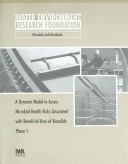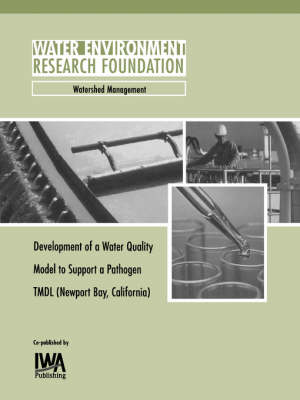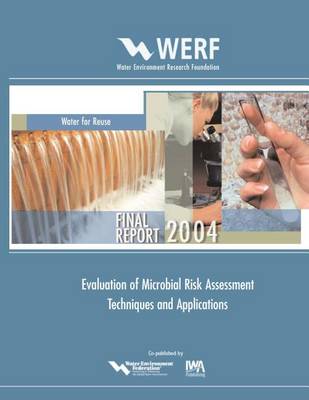WERF Research Report
5 total works
Maximum allowable levels for chemical contaminants in biosolids were developed for the Part 503 rule using risk-based methodologies. However, maximum allowable levels of microbiological contaminants in the Part 503 rule were based on specific treatment methodologies rather than risk levels, because it was determined at that time that risk assessment methodologies were not sufficiently developed. Given the current interest in the beneficial uses of biosolids and the projected rapid growth of biosolids reuse, there is increasing interest in the development of a microbial risk assessment methodology for regulatory and operational decision making. This document presents a methodology for assessing risks to human health from pathogens via exposure to biosolids. The methodology integrates two fundamental components: an exposure assessment component and a health risk component. The exposure assessment component is used to quantify pathogen levels in the environment and serves as input to the health effects component. The health effects component is used to quantify health risks using a model that explicitly accounts for properties unique to an infectious disease process, specifically secondary transmission and immunity. To demonstrate the applicability of these risk-based methods developed for biosolids exposure, numerical simulations were carried out for a case study example in which the route of exposure was direct consumption of biosolids-amended soil. The output from the case study yielded a decision tree that differentiates between conditions in which the risk from biosolids exposure is high and those conditions in which the relative risk from biosolids is low. This decision tree illustrates the interaction among the important factors in quantifying risk. For the case study example, those factors include biosolids treatment processes, the pathogen shedding rate of infectious individuals, secondary transmission and immunity. Further work in determining biosolids exposures is required before this methodology can be used in a comprehensive risk assessment. This publication can also be purchased and downloaded via Pay Per View on Water Intelligence Online - click on the Pay Per View icon below
Development of a Water Quality Model to Support Newport Bay, California TMDL
by J. F. DeGeorge, S. Grinbergs, J. A. Soller, A. W. Olivieri, and J. N. S. Eisenberg
Published 1 February 2003
Newport Bay (Orange County, California) is listed by the California State Water Resources Control Board (SWRCB) as a water quality limited receiving water body because of sporadic exceedances of the fecal coliform water quality objectives for body contact recreation. Consistent with federal and state requirements, a Total Maximum Daily Load (TMDL) is being implemented in the watershed. The fecal coliform TMDL in Newport Bay is a phased approach for understanding and controlling the microbiological water quality in the to ensure the reasonable protection of the Bay?s beneficial uses. An important initial step within that TMDL was to assess the impairment of the body contact recreation beneficial use (REC-1) of Newport Bay receiving waters through characterizing the risk of illness associated with REC-1 exposure. A health risk assessment investigation was developed to characterize that risk. The health risk assessment investigation involved the integration of a population based model of disease transmission, a water quality modeling component necessary for estimating pathogen dose as part of the exposure assessment, and site-specific population use and receiving water data collection. The Water Environment Research Foundation funded the water quality modeling component of the health risk assessment investigation, which is the focus of this report. Also provided within this report is an overview of the health risk assessment methodology, a summary of the major findings from the risk assessment investigation, and a discussion of how the health risk methodology may be applied to other watersheds where impairment of the REC-1 beneficial use is in question. The major findings of the health risk assessment investigation indicated that (1) the risk of illness from REC-1 use in Newport Bay, estimated using two separate methods was generally below levels considered tolerable by US EPA, and (2) the reduction of controllable sources of pollution would not appreciably reduce the existing risk. Based on the collection of site-specific exposure data and the health risk characterization, it was determined that evaluating the impairment of the REC-1 beneficial use requires a more rigorous and comprehensive health based approach than that prescribed by the current regulations for recreational waters.
Microbial risk assessment is a structured approach to estimating risks associated with environmental exposure to pathogens by using available environmental data. In this report the researchers took advantage of pathogen monitoring of raw sludge efficacy of treatment processes, and pathogen monitoring of post-treatment biosolids. This risk assessment approach is able to estimate risks even for Class A biosolids where post-treatment monitoring data are all below the detectable level. Using this approach this report provides risk estimates for a number of different models to gain insight into risks associated with different aspects of the biosolids treatment and application process.
This report provides an approach to conducting risk assessments that takes advantage of pathogen data from raw sludge and data on treatment process efficacy as additional data sources to the post-treatment data. In this context the raw sludge and treatment data are considered prior information that can inform the risk estimate, and the post treatment data is used to inform the likelihood. The risk assessment framework present in this report provides a mechanism to discuss biosolids management microbial risk using a common metric for comparison of treatment methods, management alternatives, and potentially to set risk-based standards for microbial contaminants in biosolids.
This report provides an approach to conducting risk assessments that takes advantage of pathogen data from raw sludge and data on treatment process efficacy as additional data sources to the post-treatment data. In this context the raw sludge and treatment data are considered prior information that can inform the risk estimate, and the post treatment data is used to inform the likelihood. The risk assessment framework present in this report provides a mechanism to discuss biosolids management microbial risk using a common metric for comparison of treatment methods, management alternatives, and potentially to set risk-based standards for microbial contaminants in biosolids.
Development of a Protocol for Risk Assessment of Microorganisms in Separate Stormwater Systems
by A. W. Olivieri, Alexandria Boehm, and Christopher A. Sommers
Published 30 September 2007
Recent research has shown that the concentrations of microbial indicator organisms (e.g., fecal coliforms) in stormwater may be quite high. However, studies have not clearly established relationships between the concentrations of indicator organisms and microbial pathogens in stormwater, or between stormwater indicator organism concentrations and illness. Thus, it is difficult to interpret indicator data collected by local public agencies in the context of potential risk to human health.
The primary objective of this investigation was to generate guidance to enable more accurate and defensible evaluations of stormwater microorganism data and the associated risks to human health from exposure to microbial pathogens in stormwater. The investigation consisted of three major tasks: reviewing and summarizing relevant published literature, conducting a web-based data questionnaire and developing a science-directed data collection plan. Topics discussed include: 1) waterborne pathogens that pose the greatest risk to human health, 2) concentrations of pathogens and indicator organisms observed in stormwater, 3) defensible relations between indicator organisms and pathogens of public health concern in stormwater, 4) the environmental fate of pathogens and indicator organisms in stormwater, 5) the use of microbial source tracking (MST) techniques to identify sources of fecal contamination, and 6) the effectiveness of stormwater microorganism control technologies and associated costs.
Additionally, recommended next steps needed to enable defensible evaluations of stormwater microorganism data and the associated risk to human health from exposure to stormwater are presented. Next steps include the development of interim guidance for management prioritization, pathogens enumeration method development, and pilot and nation-wide data collection programs.
The primary objective of this investigation was to generate guidance to enable more accurate and defensible evaluations of stormwater microorganism data and the associated risks to human health from exposure to microbial pathogens in stormwater. The investigation consisted of three major tasks: reviewing and summarizing relevant published literature, conducting a web-based data questionnaire and developing a science-directed data collection plan. Topics discussed include: 1) waterborne pathogens that pose the greatest risk to human health, 2) concentrations of pathogens and indicator organisms observed in stormwater, 3) defensible relations between indicator organisms and pathogens of public health concern in stormwater, 4) the environmental fate of pathogens and indicator organisms in stormwater, 5) the use of microbial source tracking (MST) techniques to identify sources of fecal contamination, and 6) the effectiveness of stormwater microorganism control technologies and associated costs.
Additionally, recommended next steps needed to enable defensible evaluations of stormwater microorganism data and the associated risk to human health from exposure to stormwater are presented. Next steps include the development of interim guidance for management prioritization, pathogens enumeration method development, and pilot and nation-wide data collection programs.
Evaluation of Microbial Risk Assessment Techniques and Applications
by J. A. Soller and A. W. Olivieri
Published 1 December 2003
This investigation reviewed and evaluated methodologies used for microbial risk assessment with respect to their applicability for reclaimed water applications. The investigation was comprised of five primary components: a comprehensive database of articles, reports and books describing microbial risk assessment methodologies was established and reviewed. Risk assessment techniques and models were identified for estimating the public health risk from exposure to microorganisms via reclaimed water applications. Two models were identified for further evaluation: a static (individual based) and a dynamic (population based). In the third component, the two models were evaluated to differentiate between the conditions under which models predict similar and substantially different estimations of risk. Through numerical simulation, exposure/pathogen combinations were identified when it may be appropriate to use the less complex, static model. Case study risk assessment scenarios demonstrated the model selection process for three realistic, yet hypothetical reclaimed water scenarios.The fourth component presents a constraint analysis for existing reuse regulations. The constraint analysis is carried out by documenting the existing reuse regulations. The constraint analysis is carried out by documenting the existing regs in three states for landscape irrigation and uses that comparison as a starting point to identify how microbial risk assessment may be useful within the context of existing and potential future water reuse regulations. The investigation concludes by identifying criteria for a computer interface that would allow regulatory and/or municipal agencies/utilities to take advantage of the analysis discussed in the report. This publication can also be purchased and downloaded via Pay Per View on Water Intelligence Online - click on the Pay Per View icon below



